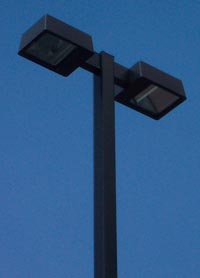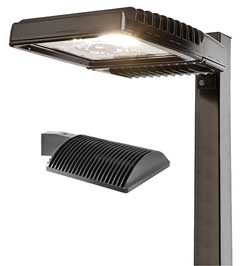Shop Our Catalog For: Commercial Parking Lot Lighting

LED Light Pole Fixtures Shine Brightest
Incandescent, fluorescent and high discharge lamps like mercury vapor, high pressure sodium and metal halides have all had their turn as the primary form of street illumination. Most of these technologies are still in widespread use, though not necessarily in commercial and large scale fixture projects.
With the rise of LED technology, those outdated fixtures will likely be pushed further away from parking lot and property illumination projects, as LEDs provide the needed power while also offering incredible efficiency, reliability, and controllability. LEDs have one-of-a-kind properties that make them uniquely suited to street illumination, and some of them include:
The Benefits of LED Light Pole Fixtures

- LEDs are extremely efficient. According to a report published in The New York Times, if the U.S. switched its street lamps to LEDs, it would save half of the energy it spends on illumination. This is due to the technology’s unmatched power efficiency. Already, LEDs can provide a comparable level of illumination at a bit less than half the wattage of high discharge lamps. And manufacturers are just getting started. This advantage will only widen as engineering processes are improved upon.
- LEDs are more durable than any other lamp. Because they are built on solid state electronics instead of with a host of delicate parts, LEDs can take the jostling that comes with sitting at the top of a street lamp. Wind can knock out other fixtures with relative ease, but LEDs can withstand wind, as well as temperatures that would rob other systems of their power.
- LEDs are practically maintenance-free for years after installation. In addition to LED’s durability, diode fixtures also offer the best longevity on the market. On average, an LED is graded for about 50,000 hours of performance, though it’s not uncommon for an LED to produce 100,000 hours’ worth of illumination. The extremely precise and granular semiconductor processes that drive the LED’s engine are easy on the fixture and produce less wear. And many LED fixtures are made with several diode chips, so if one or two blink out, the fixture itself will continue to produce adequate illumination. Municipalities and property owners are always looking for ways to reduce operational costs, and LEDs provide an obvious upgrade in this regard.
- LEDs naturally produce directional illumination. Every fixture has its own pattern of emission, and LEDs’ emit in a pattern that makes them ideally suited for exterior, elevated applications. Specifically, LEDs produce strong directional illumination that can be aimed downwards, which means they don’t need a lot of power to cast intense illumination along a road or parking lot. Some installers might consider it a disadvantage that LEDs do not produce illumination in a globe pattern, but directional fixtures also generate less light pollution, which is a prized feature in light poles.
- LEDs are lighter than other fixtures. Discharge lamps are built with bulky electrodes, ballasts and internal reflectors, and this runs up the weight of the fixture. Heavy fixtures are more of a liability during inclement weather, as high winds can swing the fixture around and cause it to fail. Heavier fixtures also require additional support to remain stable, which is an added cost of installation. LEDs don’t require bulky components like ballasts and heavy reflectors, cutting down on their weight significantly.
- LEDs can be controlled in highly useful ways. No other fixture technology is as easy to control as LEDs, and this added controllability can be utilized in a number of interesting ways. For example, LEDs can be tied to motion sensors that detect when someone is walking near the lamp. The LEDs can be brightened when detecting motion and dimmed when there is no one nearby, reducing energy consumption considerably. LEDs can also be used with emergency services to help direct first responders to an accident scene. The lamps leading to the crash can be made to change color or flash to indicate where emergency responders need to go.
In just a decade or so, LEDs have gone from an interesting technology to dream on to a frontline option for many fixture applications. Parking lot and street light poles are two of those applications, and they won’t be the last two, if the march of LED progress is any indication.







